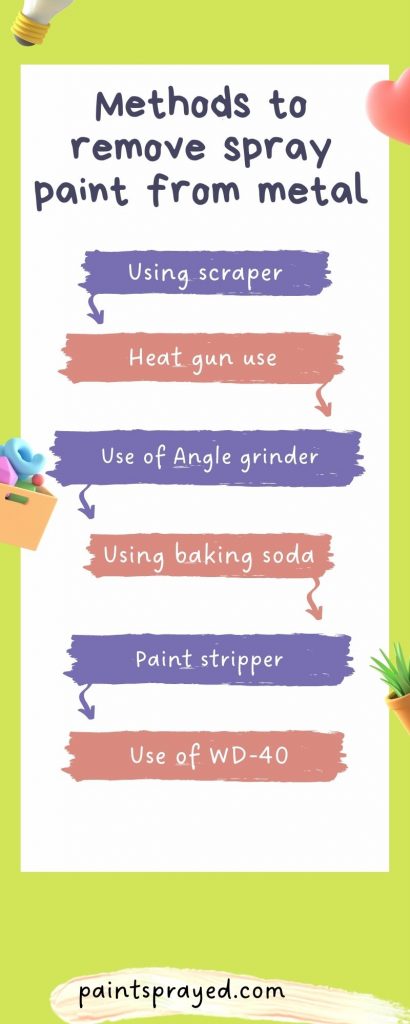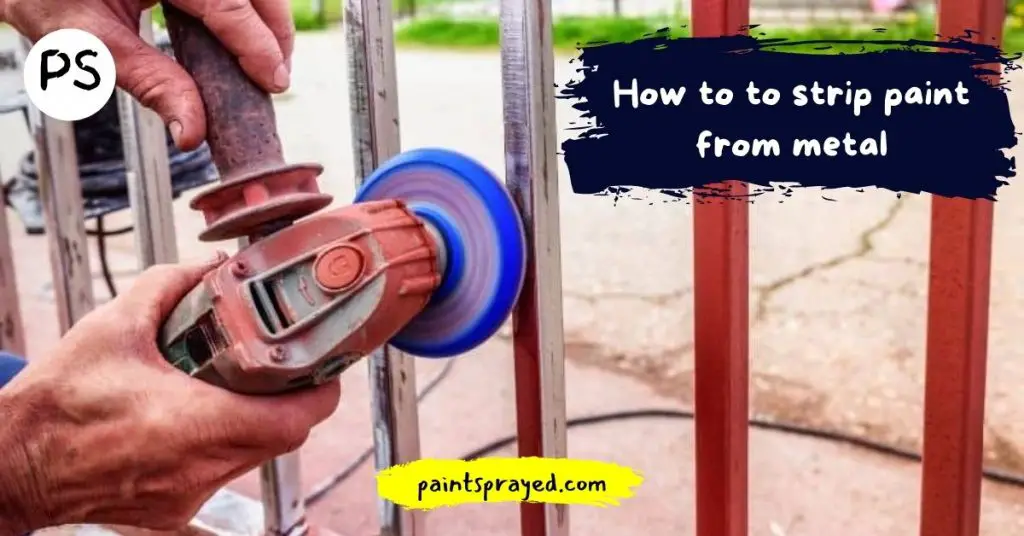Removing paint from metal? It’s not easy, but if you have the patience for it, it’s doable.
There are many ways to strip paint from metal—including safe and eco-friendly ways.
But regardless of what your preferences are, here are some things to consider before tackling your next project.
Here in this guide, I will share the methods which I use for removing spray paint from metal surfaces, Newbies will get their answers.
Most of them will be answered here in this post of mine.
Newcomers often get confused when they think of removing paint from metal surfaces because they fear that they might mess up the surface while doing so.
How to to strip paint from metal?
Tools need to do this job
- Drop cloths, plastic sheets, newspapers, or cardboard to protect surfaces
- Gloves
- Safety goggles
- Long sleeves for protection of clothes
- Dust mask for preventing inhaling bad chemicals
- Hearing protection for protection when angling the grinder
- Knife
- Paint scraper
- Chip brushes with natural bristles
- Disposable pan for paint remaining
- Hard-bristled brush
- Paint stripper
- Clean rags
- Mineral spirits for cleaning the surface

Remove paint with a scraper
The scraper can be of great help. It has a plastic or metal blade that is somewhat similar to a putty knife. The scraper will get rid of the paint with just a little bit of effort on your part.
If you are working with a softer sort of metal like brass, choose the plastic handle over the metal one in order to avoid damaging or scratching the metal’s surface.
Scrapers come in several sizes and you should pick one that’s comfortable to hold and well-suited for the job.
(A wider blade for flat and wide surfaces, as well as narrow blades, meant for small, hard-to-reach areas).
You can use this method to remove spray paint from metal filing cabinet if you want to paint it.
Using a heat gun to remove paint
To remove paint from a metal piece, start by reducing the heat setting and holding the gun about 4 inches from the object.
Slowly start at one end and apply light pressure on the trigger to direct heat to just underneath the surface of the paint.
If it doesn’t bubble, push it down harder or try again with a higher temperature.
If there’s no thick layer of paint, go ahead and scrape off any areas that did get heated up with a putty knife or scraper tool.
Once you’re finished and have given things time to cool back down, there also might be some additional residue left behind.
That’s easily removed with soap and water or any other cleaning products you prefer!
Using Angle Grinder to remove spray paint from metal
To remove the paint, there are two popular options. The first is to use a hammer and chisel which can be very noisy and dusty.
It’s always a good idea to wear earplugs and eye protection when using these kinds of tools.
If your tile has other surface treatments like grout or an additional gloss layer over the paint, this procedure can ruin them too.

The best thing to do is to attach a strip of euro disk (you can get these from hardware stores that sell painting accessories) to the angle grinder.
And let the handheld machine do all of the hard work for you!
Use of baking soda to remove paint
An easy, at-home way to get rid of the paint on your metal furniture is by mixing water with some baking soda.
And heating it up on your stove. You can use a disposable pot or any other heat-resistant vessel.
For every quart of water, add 1/4 cup of baking soda and bring the water to a boil. Drop in what you want to clean, cover it with water, and boil it for 15 minutes or so.
Be sure to wear heat-protective gloves while doing this! Now take out whatever it was you cleaned and scrape off any remaining paint with a heavy-duty brush or putty knife.
Using paint stripper
There are different types of paint strippers, including low-odor ones made from nature.
And biodegradable ingredients like soybeans – but the way to use them is pretty much the same.
Pour some paint stripper into a container. Dip a brush and apply it thickly onto your object.
Let the chemical reaction with the paint started bubbling up (this can take anywhere between 30 minutes to overnight).
Use a rag or scraper to wipe off the excess paint, followed by some more if necessary.
Always work in well-ventilated areas while wearing protective gear such as glasses only when necessary.
When dealing with chemicals you’re unfamiliar with – they don’t call them “hazardous” for nothing!
Tips for removing paint
Only use a Dremel with a twisted-steel brush and not the wire-bristled brush.
Otherwise, you might leave scratches on the surface of your cabinet hardware due to uneven wire bristles which will, in turn, make them look old or dirty.
Old toothbrushes that you’re no longer using can prove to be beneficial when trying to reach corners and creases that are too hard to get to with a standard sponge.
Follow the paint stripper’s instructions! In some cases, you’ll likely feel pressured to speed up the working time with a chemical by getting rid of it quicker.
You shouldn’t do that because that could give way to mistakes and cause irreversible damage.
It pays off to wait it out a little longer and diligently follow the number-based guidelines, especially when it comes down to peeling through layers upon layers of paint on metal.
After removing ALL of the paint and surface finish, wipe down the metal with a cloth and mineral spirits to get rid of all excess.
What is the best paint remover for metal?
There are several paint removers that are effective on metal surfaces, including:
- Stripper Gel: A thick gel that clings to vertical surfaces, allowing it to work on paint for a longer period of time.
- Aerosol Spray: A spray-on paint remover that is convenient for large surfaces and hard-to-reach areas.
- Liquid Stripper: A paint remover that comes in a liquid form and is applied with a brush or roller.
- Sandblasting: An industrial method that uses compressed air to blast an abrasive material onto the surface to remove paint.
- Heat gun: A tool that uses heat to soften the paint and make it easier to scrape off.
Ultimately, the best paint remover for metal will depend on the specific type of paint, the condition of the surface, and the tools you have available.
It’s always best to test a small inconspicuous area first before committing to a large surface.
Will vinegar remove paint from metal?
Vinegar is a mild acid that can be used to remove paint from metal surfaces.
However, the effectiveness of using vinegar to remove paint will depend on the type of paint, the age of the paint, and the condition of the metal surface.
For example, if the paint is old and chipped, vinegar may be more effective in removing it. If the paint is new and in good condition, it may be more difficult to remove.
Additionally, some metal surfaces may be more susceptible to damage from acidic solutions.
So it’s important to test the vinegar on a small, inconspicuous area of the metal surface before attempting to remove the paint from the entire surface.
Do I need to strip all paint before repainting metal?
It is not always necessary to strip all paint before repainting metal.
If the existing paint is in good condition and is well-bonded to the metal surface, it can serve as a good primer for the new paint.
However, if the existing paint is chipped, flaking, or otherwise in poor condition, it will need to be removed before repainting.
Additionally, If you are changing the color of your metal surface or if you’re painting over a glossy paint.
You should remove all the existing paint as glossy paints and colors do not adhere well to new paint.
It’s important to properly prepare the metal surface before repainting, this includes cleaning it thoroughly and making any necessary repairs to the surface.
If you’re unsure about whether or not the existing paint needs to be removed, it’s best to consult a professional or to test a small.
Inconspicuous area of the surface before attempting to repaint the entire surface.
What is the quickest way to strip paint?
The quickest way to strip paint will depend on the specific type of paint, the condition of the surface, and the tools you have available.
Some common methods for quickly stripping paint include:
- Heat gun: A heat gun can be used to soften the paint and make it easier to scrape off. This method is quick, but it can also be dangerous and can damage the underlying surface if not used properly.
- Chemical paint remover: Chemical paint removers, such as liquid or gel strippers, can be applied to the surface and left to work for a set period of time, after which the paint can be scraped off. This method can be quick, but it requires proper ventilation and protective equipment, and it can also damage the underlying surface if not used according to the manufacturer’s instructions.
- Sand blasting: An industrial method that uses compressed air to blast an abrasive material onto the surface to remove paint. This method is quick and effective, but it can also be dangerous and can damage the underlying surface if not used properly.
- Power Tools: Electric tools such as angle grinders or rotary sanders can be used with abrasive discs or sanding pads to quickly remove paint. This method is quick and efficient, but it can also be dangerous and can damage the underlying surface if not used properly.
Ultimately, the quickest method will depend on the specific conditions of your project, and it’s always best to test a small inconspicuous area first before committing to a large surface.
FAQ’s of How to strip paint from metal
Conclusion of How to strip paint from metal
Here it is peeps, the complete step-by-step guide to removing spray paint from metal surfaces with little or no effort at all.
The best way for newbies is to follow each and every step mentioned in this guide so that they don’t create any mess at all.
Feel free to comment on your queries, I will answer with my experience and will surely solve the problem which you are facing.
Professionals should also share their tips if they have any other than what I have mentioned in my post.

Matthew Edward is a professional painter who loves to paint and wants to share useful tips and tricks which he had learned in many years of experience in painting. He also used many products that can be used for painting he has tried and tested each and every product to give an unbias opinion about it in his review. This blog is very useful for those newbies who want to learn painting without making mistakes.






